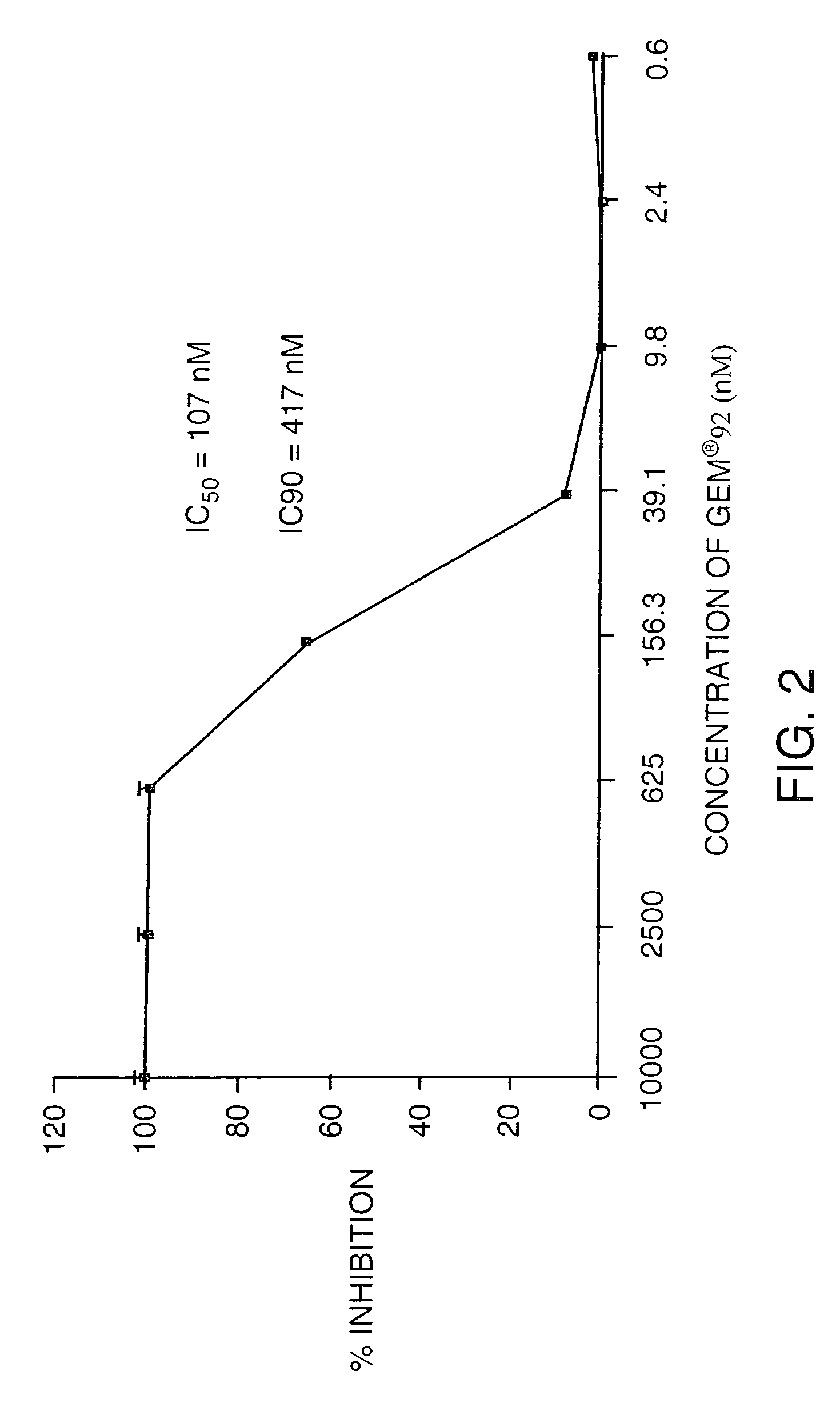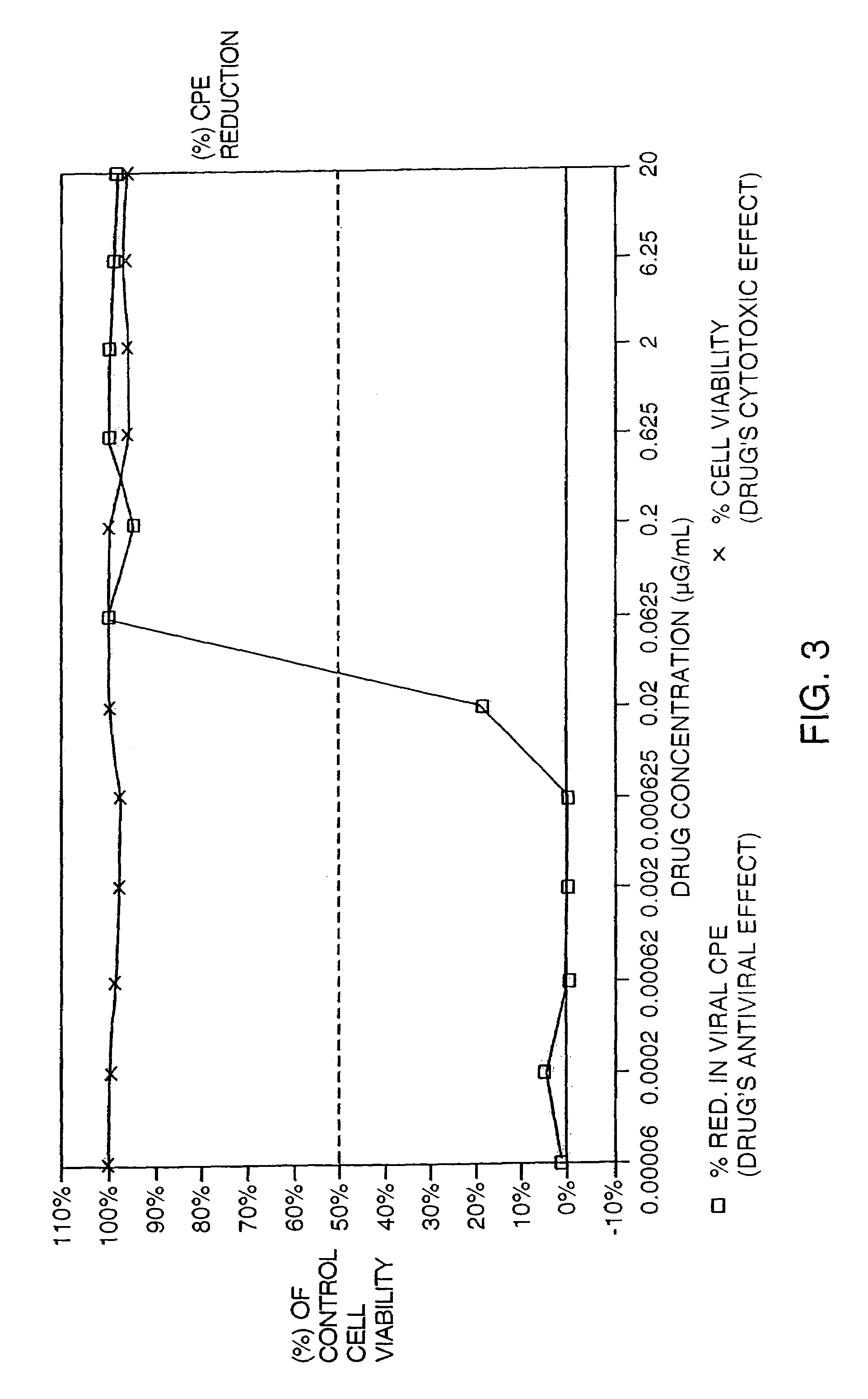HIV-specific synthetic oligonucleotides and methods of their use
a synthetic oligonucleotide and hiv technology, applied in the field of hiv infection treatment, can solve the problems of severe immunodeficiency, death of the infected organism, and the use of therapeutic agents such as nucleoside analogs 3
- Summary
- Abstract
- Description
- Claims
- Application Information
AI Technical Summary
Benefits of technology
Problems solved by technology
Method used
Image
Examples
example 1
Synthesis and Purification of Oligonucleotides
[0067]Oligonucleotide phosphorothioates were synthesized using an automated DNA synthesizer (Model 8700, Biosearch, Bedford, Mass.) using a beta-cyanoethyl phosphoramidate approach on a 10 micromole scale. To generate the phosphorothioate linkages, the intermediate phosphite linkage obtained after each coupling was oxidized using 3H, 1,2-benzodithiole-3H-one-1,1-dioxide (see Beaucage, in Protocols for Oligonucleotides and Analogs: Synthesis and Properties, Agrawal (ed.), (1993) Humana Press, Totowa, N.J., pp. 33–62).
[0068]Hybrid oligonucleotides were synthesized similarly, except that segments containing 2′-O-methylribonucleotides were assembled using 2′-O-methylribonucleoside phosphoramidite, followed by oxidation to a phosphorothioate or phosphodiester linkage as described above. Deprotection and purification of oligonucleotides was carried out according to standard procedures, (see Padmapriya et al. (1994) Antisense Res. &Dev. 4:185–1...
example 2
Propacation and Ouantitation of Cell Lines and Virus Stocks
A. Cells
[0069]The CEM-SS cell line (Southern Research Institute-Frederick Research Center, Frederick, Md.) is highly susceptible to infection with HIV, rapidly form multinucleated syncytia, and are eventually killed by HIV. The cells were maintained (2–7×105 cells per ml) in RPMI 1640 tissue culture medium supplemented with 10% fetal bovine serum, glutamine, and antibiotics, and were passaged twice weekly at 1:20 dilution. Passage number was logged each week. Cells were discarded after twenty weeks of passage and fresh CEM-SS cells thawed and utilized in the assay. Stocks of CEM-SS cells were frozen in liquid nitrogen in 1 ml NUNC vials in 90% fetal calf serum and 10% dimethyl sulfoxide (DMSO). Following thawing, CEM-SS cells were routinely ready to be utilized in the primary screen assay after two weeks in culture. Prior to replacing a late passage cell line, the new CEM-SS cells were tested in the screening assay protocol ...
example 3
Microtiter Antiviral XTT Assay
A. Cell Preparation:
[0076]CEM-SS sells (AIDS Research and Reference Reagent Program, NIH) or other established human T cell lines used in these experiments were passaged in T-150 flasks for use in the assay. On the day preceding the assay, the cells were split 1:2 to assure they would be in an exponential growth phase at time of infection. On the day of assay the cells were washed twice with tissue culture medium and resuspended in fresh tissue cultures medium. Total cell and viability counting was performed using a hemacytometer and trypan blue dye exclusion. Cell viability was greater than 95% for the cells to be utilized in the assay. The cells were pelleted and resuspended at 2.5×104 cells per ml in tissue culture medium. Cells were added to the drug-containing plates in a volume of 50 μl.
B. Virus Preparation
[0077]A pretitered aliquot of virus was removed from the freezer −80° C.) and allowed to thaw slowly to room temperature in a biological safety...
PUM
| Property | Measurement | Unit |
|---|---|---|
| Molar density | aaaaa | aaaaa |
| Molar density | aaaaa | aaaaa |
Abstract
Description
Claims
Application Information
 Login to View More
Login to View More - R&D
- Intellectual Property
- Life Sciences
- Materials
- Tech Scout
- Unparalleled Data Quality
- Higher Quality Content
- 60% Fewer Hallucinations
Browse by: Latest US Patents, China's latest patents, Technical Efficacy Thesaurus, Application Domain, Technology Topic, Popular Technical Reports.
© 2025 PatSnap. All rights reserved.Legal|Privacy policy|Modern Slavery Act Transparency Statement|Sitemap|About US| Contact US: help@patsnap.com



